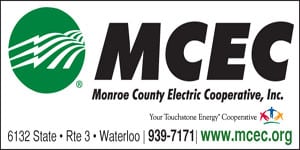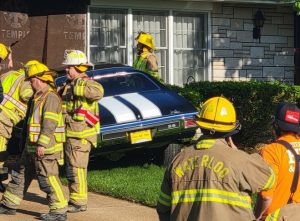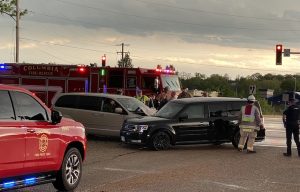Father and son bond over hobby of tractor collecting
Father and son Brian and Scott Johnson, of Valmeyer and Fults, respectively, admit to a “sickness” for tractors. They work on them together in their spare time.
As they led the Republic-Times on a tour of their collection of these farm workhorses, their enthusiasm and affection for some 38 tractors lined up neatly in a huge steel shed, and seven – or maybe eight more, if you count the newest acquisition currently in initial stages of restoration in the repair shop next door – was infectious.
It all started decades ago with Brian’s accumulating toy tractors.
“But when they stopped making them in the U.S. and started importing them from China, I refused to buy any more,” he said.
Brian and Scott are both members of the International Harvester Collectors – Chapter 32. In fact, Brian is the chapter director, leading a cadre of collectors encompassing all of southern Illinois below Interstate 70.
Most of their tractors are – or were – bright red and bear the International National Harvester Farmall name. But they aren’t snooty – there’s a venerable grey Ford just inside the shed door.
“I actually like all tractors,” Brian said. “But Grandpa had Internationals, so that kind of set the tone.”
Brian’s favorite tractor, a meticulously restored, red International Harvester Farmall Model M, dates back to 1944. His affection for it is very palpable. It was his dad’s, and was one of his first to be restored to its shining youthful appearance and functionality. It started right up smartly when Scott was asked to take it outside for a picture.
Their collection is quite inclusive.
“First, there was the letter series (including Brian’s dad’s Model M) and we have at least one of each,” Scott noted.
“Then there were the Super Series,” Brian continued.
They have at least one of each of them. And they have pretty well gotten their arms around the so-called number series, including their latest ac
quisition, a solid-running Model 240 sitting in their shop.
That tractor – the Farmall 240 – bore a single, badly damaged model emblem when they brought it home. Recently, Brian and his wife, Brenda, journeyed to the International Harvester Collectors conclave in Huron, South Dakota, where Brian went on a hunt for parts for the 240, including a pair of the traditional red oval model emblems.
“Several collectors told me they simply didn’t exist anymore,” Brian said. “But one steered me to a seller specializing in emblems, and he had three of them. He assured me they were the only ones in the entire United States. So I bought two – for $135 apiece.”
Asked which of the 45-plus tractors are rarest, Brian and Scott traded ideas.
“The white Farmall Model C is pretty rare,” Brian said.
They made them for dealers to use as demonstrators when the Model C came out.
Scott offered his favorite up as a rarity – a Super MDTA model.
“You started it on gasoline,” he said, “and then when it was running well, you shifted it over to diesel fuel. Diesel was cheaper.”
But making a tractor capable of using either fuel was quite expensive and only a few were sold.
Finally, they both cited their International Harvester Farmall 130.
“There were only 130 of them made,” Scott said. “Ours is the ninth one,” Brian added.
Returning to the lonely grey Ford in the shed, Brian told how the first tractor he drove was a Ford 660.
“I was young, it was easy to drive. But my dad needed bigger tractors to farm, and he sold it. I loved it,” he remembered.
Scott then told how he found one for sale in Jonesboro, Tenn.
“I went and got it – it was an overnight 660-mile run back,” he went on.
The next evening, at a party celebrating his dad’s retirement from 38 years as water and sewer superintendent for Valmeyer, Scott drove it into the party and presented it to him.
“He cried,” Scott remembered. “Then I cried.”
So, what do you do with 45 tractors?
“Well, they’re an investment. I don’t ever want to have to sell them, but they’re doing better than money in the bank,” Brian said.
Acquiring, restoring and driving them isn’t cheap.
“It would take more than 1,000 gallons of gasoline to fuel up the entire collection,” Brian said.
Parts can be difficult to obtain, too.
“And we have 50 spare batteries and hundreds tires,” he added.
At least one tractor doesn’t need tires. A Farmall Model H sits quietly in the shed, on four steel wheels with steel lugs.
“It was made in 1942, and the lugged steel wheels gave it good traction. And, besides, you couldn’t get tires during the war anyhow,” Brian added.
The Johnsons show their tractors in summer parade.
“We occasionally go on trail rides through the woods here,” Brian Johnson said with a smile. “It’s beautiful and we all enjoy these rides.”
What does Brian Johnson do when he’s not working on one of his tractors?
“I still have my toy tractors,” he said, surveying toy-filled glass cases in his work shop area.
And, he pointed, “I have a collection of Monroe County milk bottles, probably one of every soda bottle ever sold here, and an accumulation of local advertising – pens, cups, signs.”








